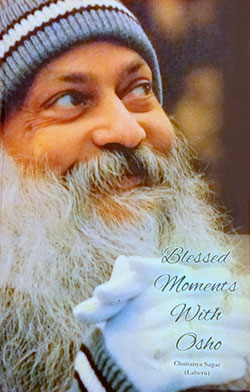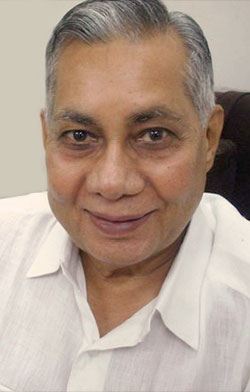‘Blessed Moments with Osho’

Tarpan reviews Laherubhai’s book that was self-published in 2016, foreword by Anando: “This book provides not only an important historical record, but also a fascinating story of Laheru’s own journey as a seeker and his experiences with the master.”
 Laherubhai, aka Chaitanya Sagar
Laherubhai, aka Chaitanya Sagar
Some years ago – it was a winter’s night in Mumbai – I came in contact with the name ‘Laherubhai’. I was going through the Osho Upanishad. It was chapter eight. There was a picture showing Osho gifting Laherubhai a painting. A sand painting of a beautiful scenery of a vast blue sky. Turning it upside down, the sky becomes a thunderstorm of swirling clouds. Osho was answering a question by Laherubhai about the mind.
Osho always called him Laheru, and not by his sannyas name. (His sannyas name is Chaitanya Sagar.) In the same Osho Upanishad series, answering Govindh Siddharth, Osho talked about calling a few people by their old names, like Lashkarji, Jayantibhai, Kakubhai, etc. Osho says, “This is not the first time they are becoming sannyasins. I know them for many lives.” Laherubhai is one of them.
‘Laherubhainess’
It was a feverish night for me; I was so eager to find out more about this man. The very next morning, somehow, I received Laherubhai’s contact number. I called him and he gave me an appointment for the afternoon.
When I reached his office at Masjid Buvan in Mumbai, the whole scenario felt like a dream. For a moment, I couldn’t believe that I was sitting in front of a man who was so dear to Osho. My mind couldn’t conceive that much ordinariness and simplicity, especially from an Osho lover. No ‘meditator symptoms’, no ‘spontaneous living syndrome’, no ‘acting of rejoicing the moment’, no ‘awareness business’, no ‘here-now’ clichés. He just smiled at me and asked my name, where I was coming from, and my profession.
I had expected that we would be talking about Osho, about meditation and that he would perhaps even appreciate me for being interested in Osho, but he simply remained sitting silently. His silence, his soothing silence was beyond all my expectations – and it was so easy for me to sit silently with him – and then I felt that all the questions I had intended to ask were absolutely irrelevant.
When I came out of his office – it was the busiest market day in Mumbai… I remember even the entire market was in an ‘everything OK’ mood. The dust, the noise, the crowd, the handcarts, the traffic, the congested roads, the nearby railway station and the jam-packed local trains, me and my thoughts, my expectations and all were absolutely OK. Yes, OK with ‘all and everything’. Somewhere inside of me I felt that relaxation is not something conspicuous; it’s rather a kind of wakeful indifference. (Or indifferent wakefulness?)
In my own vocabulary I added the term ‘laherubhainess’.
A deep let-go whether the master is alive or not
His book, Blessed Moments with Osho, definitely has the ‘laherubhainess’ in its contents and space. Perhaps this is a lovely account of that deep let-go. It starts from the very first day of meeting Osho on March 21, 1967.
This multidimensional let-go keeps going on and on, indifferent whether the master is alive or not. This is the very message he received from Osho on December 16,1988, in a letter acknowledging Laherubhai’s flowers as a birthday gift to Osho:
“The love between the disciple and the master
Is the most intimate, the most ultimate.
You have to rejoice my absence
The same way as you rejoice my presence
because I cannot remain here forever.
And do not postpone.
I am not going to come again in the body,
this is the last time.
You have to become as silent, as loving, as meditative
with me or without me.
The difference between my absence and my presence
should be completely lost.”
Recording the discourses
Laherubhai was one among the five who were with Osho when he started his work in Mumbai. And he was the one who started recording Osho’s discourses. According to him he started recording them as he was not able to understand his words in the first hearing. Just to listen to them more carefully later, he started to record every talk of Osho. It is because of Laherubhai that we are fortunate to have thousands of Osho’s early discourses!
The anecdotes
There are beautiful anecdotes in these pages where we come to know how intimate he was with Osho. We read of the many incidents and moments he shared with Osho, but they remain just as indications, without too much description. Perhaps, on some occasion, we would have wished to read more elaborations, particularly when he describes moments where Osho was involved directly. But what to do… Laherubhai kept his own pace, saying things as simple and short as possible. He might not have mentioned much of the wonderful moments, maybe to avoid going astray?
However, we read about Osho visiting Laherubhai’s house, Osho taken for an inauguration of ‘lizzad papad’, travelling with Osho to Manali for the first sannyas initiation camp, Osho visiting a bistro bar in Mumbai, initiating his own mother, visiting Laherubhai in hospital, and many more stories…
Osho travels to Manali, in 1970
One of my favourites is: when Laherubhai was travelling from Delhi to Manali in Osho’s car for the Manali camp (September 26, 1970), the road was very bad and there were no facilities for refreshment. Laherubhai told Osho that the journey was very difficult. But Osho answered, “The journey is difficult and tiresome. But when we reach the destination, we will feel altogether different.” I feel, that particular ambience and Osho’s words must have done a miraculous work on the listener.
“I take you to the middle of the ocean, and then leave you”
There is another wonderful moment Laherubhai shares with us – for me this is the most touching incident in the book – it was from an evening walk with Osho on the seashore. He writes, “Once when we were walking on Nariman Point, he said to me, ‘Laheru, do you see this ocean? I am the kind of person who will hold your hand and take you to the middle of the ocean, and then leave you.’” And Laherubhai says that at that time he couldn’t understand what Osho meant. But by that time, Osho had already done it, right? And now, he is submerged with ocean, of blessings and bliss!
Osho, perhaps this is what you are doing with every Osho lover? Holding our hand and taking us to the middle of the ocean? And we are bound to learn diving!
Falling into a ditch again and again
Many such blissful moments are remembered in this book. For instance, in Chapter 33, during a Hindi discourse series – it might be the first time that this discourse is translated into English – Osho replies to Laherubhai who asks for a simple guidance about falling in the same ditch again and again like a donkey.
Osho reminds Laherubhai – and us too – that it is others that are calling it a ditch, we don’t see it so. Not only that, we will be enjoying the ditch as some lovely place. We will be enjoying each falling. We would think to fall once again! We are so sleepy, so dreamy, so unconscious that we don’t know what we are actually doing.
“That is why,” Osho says, “I am pushing you. I am shaking you. I go on hurting you, I go on hurting you mercilessly. I demolish your prejudices. I make you displeased, I make you angry also because you don’t want that your prejudices should be demolished. But this seems to be the only device, that you may wake up.”
He will awake us from sleep so that we will see a ditch as a ditch and we will not fall into it again, and will not complain either. We will be watchful enough. This is what sannyas is all about.
A book for your favourite spot on the bookshelf
With the many rare black and white photographs, this book may well be kept next to those old darshan diaries on your bookshelf.
Review by Tarpan
The book was originally written in Gujarati and translated into English by the author. It has been self-published and is available as a hardbound book from Osho Viha or from the author: [email protected]
Read excerpts from ‘Blessed Moments with Osho’ on Osho News
Laherubhai (aka Chaitanya Sagar, Laherchand B. Shah) was born in August 1938. At the age of 28, in 1967, he met Osho. He has been running his own business in Mumbai and Osho insisted he continue his job, along with meditation, and asked him to remain in ‘the market place’. In the same building as his office, he and other Osho friends started the first meditation centre. Laherubhai lives in one of Mumbai’s busiest districts.
- Log in to post comments
- 14 views
